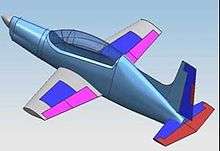HAL HTT-40
| HTT-40 | |
|---|---|
| | |
| Model of the HAL HTT-40 | |
| Role | Basic training aircraft |
| National origin | India |
| Manufacturer | Hindustan Aeronautics Limited |
| First flight | 31 May 2016[1] |
| Status | Under development |
| Primary user | Indian Air Force |
| Number built | One prototype |
| Unit cost | |
The HAL HTT-40 aircraft project is a Hindustan Aeronautics Limited (HAL) proposal for an indigenous replacement for the Indian Air Force's retired HPT-32 Deepak as a basic trainer.[3][4]
Design and development
The HTT-40 will be an all-metal tandem seat aircraft powered by a 1,100 hp (820 kW) turboprop engine. In early 2012 the company forecast building 106 examples.[4]
By the middle of 2012 the aircraft's future was in doubt as the Indian Air Force ordered 75 Pilatus PC-7 Mk IIs to fill the role envisioned for the HTT-40. In September 2012 the Air Force indicated that it had formally rejected the HTT-40 for service based on its cost per aircraft being double that of the PC-7 Mk II, a proven aircraft already in service worldwide. An MoD official noted, "We would be willing to pay higher rates to build indigenous capability in strategic defence equipment. But can HAL argue that the capability to build basic trainers is strategically vital[?]"[5][6][7]

HAL did not confirm the IAF announcement that it will not buy the HTT-40, nor would the company indicate whether the aircraft's development will be continued. A company spokesman said, "We treat all MOD issues/proposals as confidential...All our projects are conceived with national interest in mind though, at times, some of those take time to fructify".[5]
On 28 February 2015, it was reported that Indian defense ministry has selected 68 HAL HTT-40 trainers and 38 Pilatus trainers to replace its current trainer aircraft fleet stating that this move was "commercially viable".[8]
On 21 June 2015, HAL chose the Honeywell Garrett TPE331-12B turboprop to power the trainer.[9]
HAL rolled out the first prototype on 2 February 2016.[10]
The HAL HTT-40 had its first flight on 31 May 2016. It was piloted by HAL's chief test pilot, Group Capt Subramaniam (Retd). The flight lasted for about 30 minutes. The pilot carried out circuits and the aircraft performance was satisfactory.[1]
HTT-40 made its first public introduction flight on 17 June 2016, with Defence Minister Manohar Parrikar in attendance at the HAL airport in Bangalore.[11]
Specifications (HTT-40)
Data from HAL[4]
General characteristics
- Crew: 2
- Gross weight: 2,800 kg (6,173 lb)
- Powerplant: 1 × Honeywell Garrett TPE331-12B turboprop, 820 kW (1,100 hp)
Performance
- Maximum speed: 600 km/h (373 mph; 324 kn) [12]
- Range: 1,000 km (621 mi; 540 nmi)
- Service ceiling: 6,000 m (19,685 ft)
Armament
References
- 1 2 "HAL-built HTT-40's first flight successful". One India. 31 May 2016. Retrieved 31 May 2016.
- 1 2 "HAL's trainer pitted as Rs 4,500 cr cheaper than Swiss Pilatus trainer". Business Standard. 15 April 2013. Retrieved 16 April 2013.
- ↑ HAL Offers New Basic Trainer to Air Force Archived December 17, 2010, at the Wayback Machine.
- 1 2 3 Hindustan Aeronautics Ltd (n.d.). "Hal htt-40". Retrieved 8 May 2012.
- 1 2 Shukla, Ajai (19 December 2012). "MoD rejects HAL's proposal to build basic trainer". Business Standard. Retrieved 19 December 2012.
- ↑ "Basic trainer for IAF | Millennium Post". Millenniumpost.in. 2012-06-22. Retrieved 2012-11-28.
- ↑ SP's Special Correspondent (2012-06-18). "HAL scouts engine for HTT 40 basic trainer - SP's Aviation". Spsaviation.net. Retrieved 2012-11-28.
- ↑ "Parrikar: 68 basic trainer aircraft to come from HAL, 38 from Pilatus". The Indian Express. 1 March 2015. Retrieved 1 March 2015.
- ↑ "HAL Chooses TPE331 for New Indian Basic Trainer".
- ↑ "Boost to Make in India: HAL Rolls-out HTT-40 Prototype". The New Indian Express. Retrieved 2 February 2016.
- ↑ "Indigenous HTT-40 trainer aircraft makes inaugural flight - Times of India". indiatimes.com. Retrieved 17 June 2016.
- 1 2 "Our trainer aircraft 40 times better than F-16s". Bangalore Mirror. 6 February 2013. Retrieved 9 February 2013.
External links
| Wikimedia Commons has media related to HAL HTT-40. |